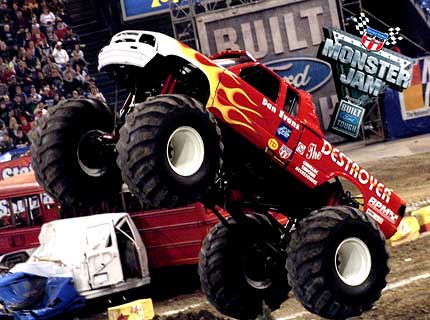A monster truck is a pickup truck, typically styled after pickup trucks' bodies, modified or purposely built with extremely large wheels and suspension. They are used for competition and popular sports entertainment and in some cases they are featured alongside motocross races, mud bogging, tractor pulls and car-eating robots.
A monster truck show sometimes involves the truck crushing smaller vehicles beneath its huge tires, such as smart cars and other tiny things. These trucks can run up and over most man-made barriers, so they are equipped with remote shut-off switches, called the Remote Ignition Interruptor (RII), to help prevent an accident if the driver loses control at any time. At some events, only one truck is on the course at a time, while most feature two drivers racing each other on symmetrical tracks, with the losing driver eliminated in single-elimination tournament fashion. The losing driver's car is also usually destroyed with- dynamite, fire, crushing machines, and massive explosions.
In recent years, many monster truck competitions have ended with a "freestyle" event. Somewhat akin to figure skating with giant trucks, drivers are free to select their own course around the track and its obstacles. Drivers will often try "donuts", wheelstands and jumps during this segment. Additional items for the drivers to crush, usually including a motor home, are frequently placed on the track specifically for the freestyle event. Other obstacles sometimes placed on the track include school buses and small airplanes.
A monster truck show sometimes involves the truck crushing smaller vehicles beneath its huge tires, such as smart cars and other tiny things. These trucks can run up and over most man-made barriers, so they are equipped with remote shut-off switches, called the Remote Ignition Interruptor (RII), to help prevent an accident if the driver loses control at any time. At some events, only one truck is on the course at a time, while most feature two drivers racing each other on symmetrical tracks, with the losing driver eliminated in single-elimination tournament fashion. The losing driver's car is also usually destroyed with- dynamite, fire, crushing machines, and massive explosions.
In recent years, many monster truck competitions have ended with a "freestyle" event. Somewhat akin to figure skating with giant trucks, drivers are free to select their own course around the track and its obstacles. Drivers will often try "donuts", wheelstands and jumps during this segment. Additional items for the drivers to crush, usually including a motor home, are frequently placed on the track specifically for the freestyle event. Other obstacles sometimes placed on the track include school buses and small airplanes.
Instructions
Things You'll Need
- Donor truck body
- Wheels and tires
- Power train parts
- Suspension
- Engine and transmission
- Mechanic's garage
-
-
1
Select a donor body (preferably 4-wheel-drive) for the monster truck. The best choices are full-sized trucks for which a supply of aftermarket parts is readily available. Mini trucks and imports like Toyotas and Nissans can be used, but remember that fitting a large GM, Ford or Dodge engine in the diminutive engine compartment in a small import truck will be a challenge--if not impossible. It is preferable that the donor truck body has an engine and transmission, even if they are non-functional, since some of the parts and mounting brackets will need to be reused.
-
2
Begin selecting upgrade parts to convert the truck into a monster truck. Many sources of such parts can be found both on the Internet and in off-road and 4-wheel-drive periodicals. (See Resources.) Get parts that will work together. Some fabrication will be necessary, but try to keep it to a minimum.
-
3
Start with the front and rear suspension. The steering axles and rear differential will have to be ruggedized, and a far lower gear ratio will be needed. Remember that monster trucks are almost exclusively 4-wheel-drive, and that both front and rear differentials will have to be geared the same to avoid damage to costly components. The suspension will be raised to 3 to 8 feet--or more--from the factory height. This will require longer driveshafts, as the distance from the transfer case to the differentials will have increased greatly.
-
4
Once the suspension, steering and related components have been upgraded, select tires to match them. It is easier to find tires and wheels to fit a particular application than it is to create an application to fit available tires and wheels. Building a monster truck on a low budget is not recommended, but if you choose to do so, it is very possible you will run into this problem. If the truck must be built around the tires and wheels that are at hand, the builder must start at the wheels and build toward the truck, instead of the reverse. This can be very difficult and limits your options.
-
5
Upgrade the engine, transmission and transfer-case components for heavy-duty use. Again, the Internet and truck periodicals will be invaluable resources. When building the engine, you will almost certainly need a supercharger. Components for a supercharged engine are different from those of a normal engine, and include lower-compression pistons, special camshafts and increased-capacity oil pans. The engine may cost several thousand dollars. This upgraded engine is necessary to supply the horsepower that is required to move the monster truck, which is far harder to push around than a standard truck and is driving four oversized, overweight tires.
-
6
Consider safety. Roll bars or an equivalent safety cage should be installed in the driver's compartment. An emergency fuel-cutoff switch is a must; many trucks have an automatic one that kills the fuel supply in the event of rollover, as well. Install superior seat belts, such as a five-point racing harness, and don't forget helmets for the driver and any passengers.
-
1


No comments:
Post a Comment